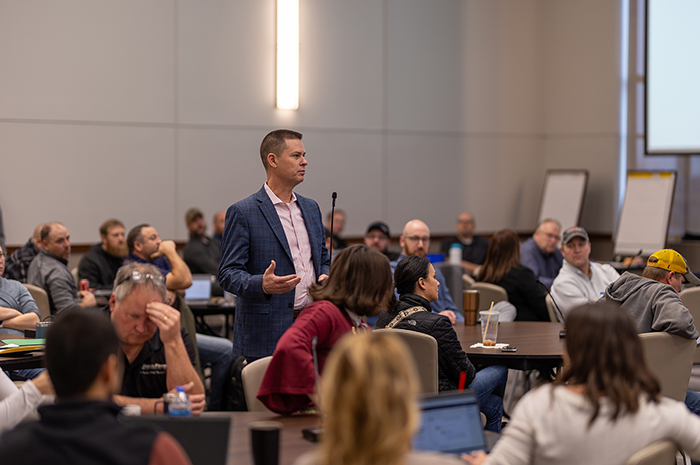Data from the depths
New 3D geophysical survey results will help clear another hurdle for Project Tundra's future.
One would assume a research geophysicist’s days would be spent looking at a lot of rocks and scientific formulas – a bland assortment of optical stimulation. But lately, Amanda Livers-Douglas’ eyes have locked on rock-layer rainbows.
“Right here is the Broom Creek Formation,” she said, pointing to a vivid 3D rendering of North Dakota’s subsurface geology. “We can see between these two rock layer boundaries, determine how thick they are, at what depth they are and how that depth changes from this side to the other side.”
This deep visual data comes from a November seismic survey conducted near Minnkota’s coal-based Milton R. Young Station, south of Center, N.D. The survey, led by Minnkota with technical support from the Energy & Environmental Research Center (EERC), had several aims. Among those goals was confirming that the site’s underground composition would be well suited for the safe carbon dioxide (CO2) storage proposed with Project Tundra.
Project Tundra is a Minnkota initiative to capture 90% of the CO2 emissions of its Unit 2 generator at the Young Station and store it permanently more than a mile underground. The geologic formations Minnkota is examining for storage are thought to be optimal for securely locking the CO2 between impermeable rock layers. However, only a system of geophysical tests and analysis can reaffirm that to acquire the permits necessary to move forward.
“With the seismic survey, we essentially took a CAT scan of the earth, imaging down to 10,000-plus feet below the surface. I’m basically the ‘radiologist’ that reads the image that we get back,” Livers-Douglas said.

Livers-Douglas used existing data from a stratigraphic test well (drilled in a single vertical site to acquire core samples, pressures, etc. of rock layers) and extended those geologic properties out through the area that the seismic survey covers. She was then able to determine if there are bumps or structural highs that might trap CO2.
The seismic data map will also show faults or cracks in the layers.
“If there were faults to be seen, those red and blue lines would be off set, and we don’t see that here,” said EERC principal geologist Wes Peck, gesturing to solid and parallel lines. “If you have an offset of the rocks that’s sharp, that means they’re probably not continuous – they’re broken – and there could be a pathway that fluids could move from your storage site up to where you don’t want them to be. There’s no evidence of that in the study area.”
EERC analysis of the seismic survey site showed nothing out of the ordinary in the potential storage zone’s composition and structure – essentially a green light for the carbon storage research’s next steps.
“Unexciting was exactly what we wanted,” Peck said.
Dynamite data
To explain a seismic geophysical survey simply, it is a process of setting off many small, deeply buried charges – in this case, 605 of them, 200 feet underground – around a given area, and then using hyper-sensitive surface sensors to record vibrational data as the waves travel down and up through the subsurface. For the November survey, nearly 1,200 sensors were placed by hand in a 6.7-square-mile area in just a day and a half.

The method is safe and common in the energy industry. And now, with the latest software, the process of harvesting and analyzing the data is easier and more dynamic than ever.
The seismic data not only shows the 3D rock layer boundaries, but also the geological composition of those layers. “Are we going from a sand to a shale, or a shale to a sand? Or is that a shaley sand? All that information can be derived from this seismic signal,” Livers-Douglas said.
Having analyzed the survey’s findings, the EERC’s next step will be helping with the coring and geophysical logging of a stratigraphic test well Minnkota plans to drill in the spring. The well – placed within the survey area, 1.5 miles south of Center – will capture further geologic information about several potential CO2 injection layers, as well as about the cap rock layers above and below that would seal the CO2 in place.

Next steps
The seismic and test well data will be integrated into a computer model that simulates CO2 injection and predicts how the CO2 would move in the subsurface.
“This modeling helps us better understand injection rates and pressures needed to inject a certain amount of CO2 into one of the proposed storage zones over a certain amount of time. It will also show how the CO2 will spread out through the proposed storage zone over time,” Livers-Douglas explained.


These figures will give Project Tundra the data it needs to attain the next of multiple authorizations – a storage facility permit. Dan Laudal, Minnkota environmental manager and Project Tundra project manager, says the process to get a CO2 storage facility permitted is more demanding than any other program for injecting fluids into the subsurface. Although geologic storage of CO2 has safely occurred in the U.S. and across the world for decades, it is still rare at the scale of Project Tundra.
“When it’s relatively first-of-its-kind, you have to account for all the possible scenarios,” Laudal said.
The permit will document to the state Minnkota’s knowledge of the subsurface and CO2. The next permit – a storage license – brings together all of the science, legal and pore-space ownership interests into a common package to allow Minnkota to license the entire facility to inject CO2. Minnkota hopes to submit that application by the end of the year, where it faces an up-to-12-month review and approval process.
The decision to move forward on Project Tundra will be made in 2021. With a solid base of state and federal support, vibrant geologic data, and strong research and design partnerships, the future of the initiative looks positive.
“Working with the EERC’s expertise has been a huge asset for Minnkota,” Laudal said. “And it’s right here in Grand Forks, which is fantastic.”
“We’ve been working here at the EERC in the carbon capture and storage business for over a decade. It’s really exciting to see a commercial-scale project that looks so promising,” Peck said. “Minnkota is one of only a few facilities across the U.S. that are on a path to implementing carbon capture and storage in the next several years.”
Main image: EERC geophysicist Amanda Livers-Douglas presents her analysis of a geophysical survey conducted in November near Center, N.D. The seismic data is color-coded to show different layers in the subsurface. (Kevin Jeffrey/Minnkota)
...



